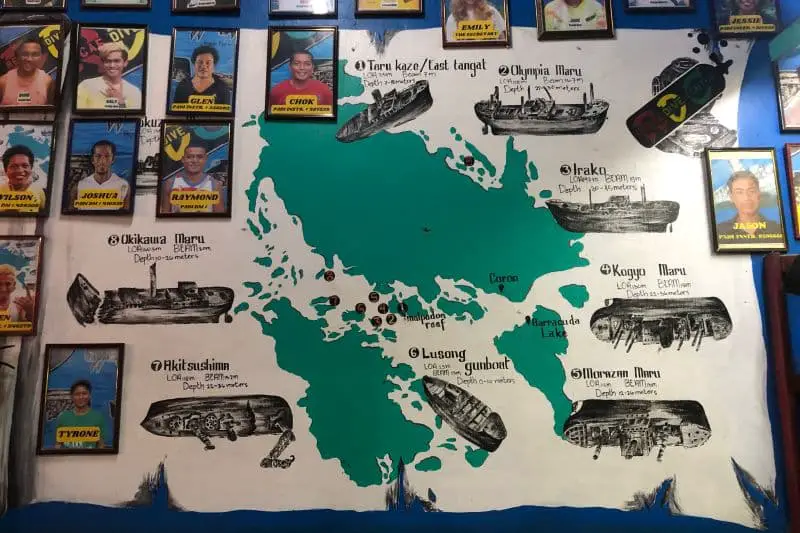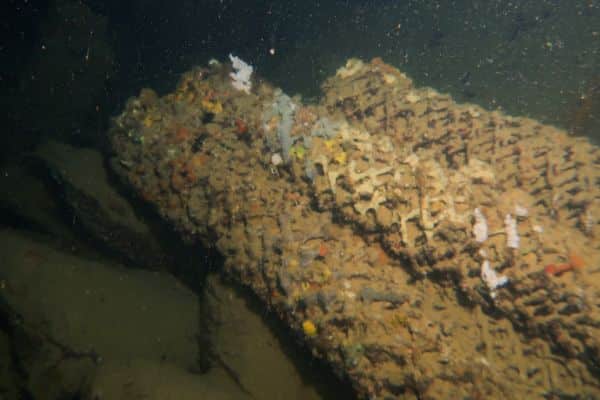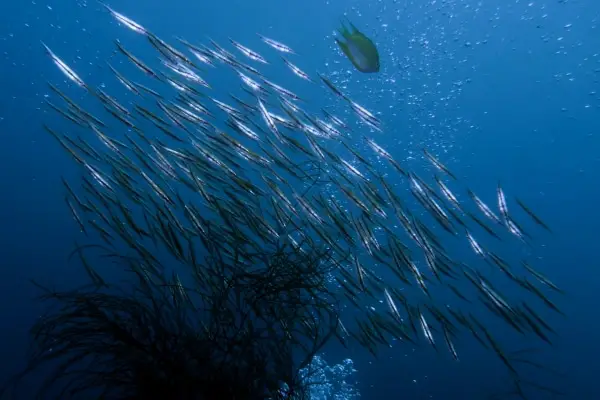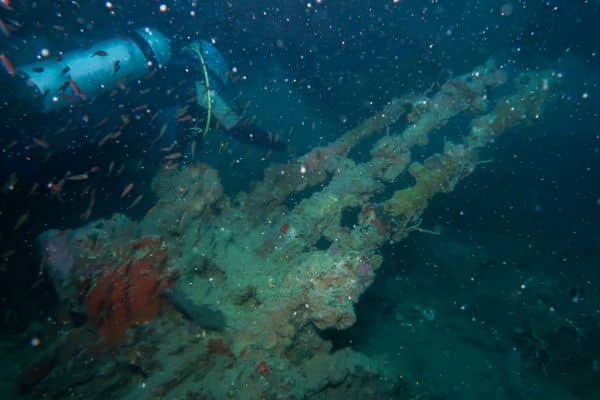I’ve explored multitudes of dive sites in the Philippines, but wreck diving never captured my heart—until I went scuba diving in Coron. Having visited Coron twice this year, I am eager to share my personal experiences and insights in this guide to diving Coron.
Nestled in the Calamian Islands of the Philippines, Coron shattered my preconceptions of wrecks. The historical remnants of World War II—like the Olympia Maru, Okikawa Maru, and Kogyo Maru—tell stories through intact corridors and cargo holds teeming with marine life. Yet, it’s not just wrecks that astounded me. The vibrant coral gardens and experience of diving in a lake absolutely blew my mind.
This blog post condenses the essence of diving in Coron, offering essential tips for divers of all levels. Whether you’re a seasoned explorer or a beginner, this diving Coron guide will help you plan your trip.
About Coron
Coron is a municipality located on the eastern part of Busuanga Island, in the Palawan province of the Philippines. It is situated in the Calamian Islands, which are part of the larger Palawan province. Nestled between the Sulu Sea to the west and the Philippine Sea to the east, the municipality encompasses several islands, including Busuanga Island, Coron Island, and nearby smaller islets.
The indigenous people of Coron are primarily part of the Tagbanua tribe. The Tagbanua have a deep connection to the land and sea, and their traditional practices and beliefs are still preserved in some areas. They have a rich cultural heritage and play an essential role in promoting sustainable tourism and protecting the natural resources of the region.
Coron has gained recognition as a premier tourist destination in the Philippines. The region offers breathtaking island-hopping opportunities, allowing visitors to explore picturesque lagoons, white sand beaches, and towering limestone cliffs. Popular attractions include Kayangan Lake, Twin Lagoon, and Malcapuya Island.
Coron’s shipwrecks from World War II have become renowned dive sites, attracting divers from around the world. The wrecks provide a unique underwater experience and is considered to be one of the best dive spots in the Philippines.
History of the Coron Wrecks
The wrecks of Coron can be traced back all the way to the 2nd World War. Coron Bay served as a strategic anchorage and shelter for the Japanese fleet, offering protection from air raids and allowing them to maintain a strong presence in the region. Recognizing the importance of neutralizing this threat, the US military planned a massive aerial assault on the Japanese ships anchored in Coron Bay.
On September 24, 1944, the American forces attacked the Japanese ships with relentless firepower. The air raid targeted the vessels and supply ships to cripple the Japanese Navy and disrupt their logistics.
The Japanese fleet in Coron Bay faced heavy losses during the attack. Multiple warships, including the seaplane tender Akitsushima, cargo ships like the Kogyo Maru and Olympia Maru, and other vessels, were sunk or severely damaged. The devastating assault dealt a significant blow to the Japanese naval forces and their ability to sustain operations in the Philippines.
The sunken vessels became submerged relics of the war, later discovered and explored by divers, attracting international attention and cementing Coron’s reputation as a premier wreck diving destination.
The wrecks now serve as historical reminders of the intense conflict that took place in Coron Bay during World War II. They offer divers a chance to witness the remnants of that pivotal event, providing a unique and poignant diving experience that combines the exploration of underwater heritage with the beauty of marine life thriving amidst the sunken artifacts.
Wreck Diving in Coron
Coron has more than 12 wreck dive sites to choose from, each offering unique features and marine life. What’s cool about the Coron wrecks is their location. Most of the wrecks are 5-10 minute boat ride away from each other so it’s very accessible. The Coron wrecks also lie in not very deep waters so both beginners and experienced divers can enjoy diving here.

Teru Kaze Maru / East Tangat Gun Boat
The Teru Kaze Maru is a tiny patrol boat that sunk in shallow seas on Tangat Island’s east shore. The bow begins at 4 meters and descends on a slope to a maximum depth of 20 meters, making it ideal for open water divers. It’s mostly intact, with a few minor holds that can be penetrated. This Coron wreck diving spot is ideal for looking for macro creatures.
Olympia Maru



The Olympia is a 128-meter (420-foot) freight ship commandeered by the Imperial Japanese Army during WWII.It is located at a depth of around 22-32 meters (72-105 feet) and provides an exciting diving experience for advanced open water divers. Its large cargo allows decent penetrations for beginners Large schools of fish like yellow snappers and jacks can be found on the main deck level. Lionfish, scorpionfish, and crocodile fish are plentiful on this wreck, so keep an eye on your buoyancy. The Olympia’s sides are covered in corals, and it’s a great area to look for seahorses and ghost pipe fish.
Irako
The Irako is a Japanese refrigeration supply ship that lies at a depth of roughly 40 meters (130 feet) and is one of Coron’s largest wrecks, measuring 145 meters (475 feet). The ship is mostly even if it took a direct hit at the bridge during World War II. Irako is considered to be one of the more deep, darker and dangerous wrecks in Coron. It can be penetrated, however, many of the passageways are smaller and darker than those seen on other wrecks in the vicinity. A large school of jacks swimming around the pole is frequent on the outside. Snappers, groupers, barracuda, and lionfish congregate around the wreck’s apex.
Kogya Maru


The Kogyo Maru was a 128-meter (420-foot) Imperial Japanese Navy construction supply ship. Laying on its starboard side, its final resting place is just 36 meters (118 feet) underwater. Concrete sacks, cement mixer, a bulldozer, and rolls of chain link fence are among the artifacts that can be found in this Coron shipwreck. Similar to the other wrecks in Coron, it is encrusted with soft and hard corals, sponges. This diving spot is home to razor fish, bat fish, snappers, groupers, lionfish, and occasionally crocodile fish.
Morazan Maru



The Morazan was a 93-meter (305-feet) British passenger ship that was taken by the Imperial Japanese Navy during World War II and put to use in Japan’s military operations. This shipwreck is currently resting on the starboard side at 25 meters of seawater. The engine room of the Morazan contains two enormous boilers, which are the primary attraction of this site. Divers of all skill levels will find something of interest on this wreck. Those with less experience should feel comfortable in the large open holds as well as the engine room. For a more challenging option, divers have the option to do a complete swim-through from the bow to the stern of the ship without having to exit the vessel at any point.
Lusong gunboat


The Lusong Gunboat is a small Japanese patrol boat that rests in relatively shallow waters, making it accessible to divers of different skill levels. This shipwreck reaches a maximum depth of 10 meters and during lowtide you can see portions of the boat breaking the surface. The wreck is covered in vibrant corals and sponges, providing a beautiful backdrop for underwater photography. The surrounding area of the gunboat is a coral garden where you can encounter colorful reef fishes like butterflyfish, anthias, chromis, surgeonfish, and more. Because of the shallow depth and beautiful coral reef, this is also a popular spot for snorkelers and freedivers.
Akitsushima



The Akitsushima was a seaplane tender for the Japanese Navy that measured 118 meters (387 feet) in length. The enormous crane that was used to lift the flying boat “Emily” now lies on the sand. When searching the outside of the shipwreck, it is still possible to identify her anti-aircraft weapons. Extra caution is required while diving the wreck because live ammunition can still be found in this dive site. The massive explosion that caused the sinking of the Akitsushima nearly tore her ship in two parts but this made it simple to penetrate the wreck. Because there are a lot of tight spaces within, having good buoyancy is an absolute requirement. Because of its depth, which can reach approximately 36 meters (118 feet), it is considered to be one of the most challenging wrecks to dive in Coron.
Okikawa Maru



The Okikawa Maru was a Japanese oil tanker that met its fate during the war. Unlike the other ships that sank on September 24th, 1944, the Okikawa Maru actually burned for days. It finally sank on October 9, 1944 when another US Airgroup struck and sent it to its watery grave. It lies at a depth of approximately 26 meters (85 feet) with the main deck level at 18 meters (59 feet). A wide variety of coral growth may be found on the shipwreck, and there is a high population density of macro creatures there as well. Divers can swim through the cargo holds and explore empty oil tanks.
Scuba Diving Barracuda Lake in Coron

Barracuda Lake is another dive site in Coron worth doing. Divers may anticipate a one-of-a-kind experience of scuba diving in lake that has both thermoclines and haloclines. As you decend you can feel the changes in temperature ranging from 30-38 Celcius. With the haloclines, which is a combination of fresh and salt water, your buoyancy skills will be put to a test.
Diving with Dugongs

If diving with dugongs is on your bucket list then you might have the opportunity to do so while in Coron. Make your way to Calauit Island, where you can interact with these adorable sea cows.
If you’d like to learn more about marine life you might encounter in the Philippines, read these posts:
15 Dangerous Sea Creatures in the Philippines
Marine Life in the Philippines: 100 Sea Creatures You Must See
Coron Diving Conditions
Water Temperature
The water temperature in Coron ranges from 24 to 30 degrees Celsius (75.2 to 86 degrees Fahrenheit) throughout the year.
A 3mm wetsuit is recommended for most divers. This is a matter of personal preference and tolerance for cold. Full suit is advised for extra protection while exploring the wrecks with tight spaces and dangerous marine life.
Visibility
The water visibility for Coron diving can vary depending on the season, weather conditions, and dive site. Generally, the visibility ranges from 10-30 meters (33-98 feet), with some sites offering up to 40 meters (131 feet) of visibility on a good day.
The best visibility is usually during the dry season, from November to May, when the water is calmer and clearer. However, even during the rainy season, from June to October, the visibility can still be good at certain sites.
Nitrox
It is recommended to dive with enriched air or nitrox in Coron. Diving depths can range from 18 meters to over 40 meters, and nitrox can increase bottom time and reduce the risk of decompression sickness. Nitrox is available at most dive centers on the island. If you are not yet certified for Nitrox, you can easily get certified with the PADI or SSI dive shops in Coron.
When is the best time to go diving in Coron?
The dry season from November to May, is the most favorable time to go diving in Coron. The best time is from April to May, which is considered to be the summer months in the Philippines. During this time the water are normally calmer and the visibility is better during this time.
It is crucial to note, however, that Coron is a year-round diving destination, and diving may still be done from June to November. While visibility may be limited during this time, you can still enjoy the reefs and wrecks Coron has to offer.
Amihan and Habagat: Diving Seasons in the Philippines Explained
Best Time To Dive in the Philippines + Monthly Guide on Where to Go
Dive Shops in Coron
Coron is home to several reputable dive shops. During my trip, I dived with Reggae Dive Center. I chose them as they came highly recommended by other divers and because of the dive itinerary they had during my visit.
Reggae Dive Center
As a solo traveler, I occasionally worry about feeling excluded or not being able to completely enjoy the dive. The employees at Reggae Dive Center made me feel welcome and included from the time I arrived. From the time I stepped foot in their shop, their staff made me feel comfortable. Despite the busy atmosphere, they addressed any question and concerns I had about the dives.
Another noteworthy feature was their hotel pick-up service. I loved not having to worry about transportation and could instead concentrate on the thrill of the upcoming dives.
When I arrived on board, I did notice that the boat was packed. It was a bit overwhelming for me and I prefer diving with smaller groups but it didn’t matter since we were eventually assigned smaller groups.
The 4:1 diver-to-dive-master ratio was a big benefit. I was assigned to a group with the same experience or level as mine so it wasn’t an issue during the dive. Our guide Wilson gave thorough dive briefings and kept a close watch on all of us during our dives.
Reggae Dive Center provided us with tasty meals for lunch. They also served beer at the end of the dive day which I thought was a nice touch.
Another disadvantage was that nitrox was not available during my visit. It would have been beneficial to have Nitrox available especially since we were diving wrecks. I noticed that compared to my previous Nitrox dives in Coron, we were ending our dive earlier to avoid going into deco.
I did 6 dives with them in 2 days. Their 3 fun dives with lunch package cost Php5000 (USD100).
Here are some of the highly recommended dive centers in Coron:
Umali Dive Center
Neptune Dive Center
Corto Divers
Coron Divers
Pirates Divers
These Coron dive centers provide a variety of dive courses, packages, and lodging alternatives to suit every budget and level of diving expertise. These diving shops are ideal for anyone wishing to discover the underwater world of Coron since they have competent and certified dive instructors, well-maintained dive gear, and a focus on customer satisfaction.
Coron Liveaboards
If you would like to go on a liveaboard, you can check out these vessels that include Coron in their itinerary.
1. M/Y Resolute – Far East Liveaboards Inc
Read my full review of Resolute’s Coron-Apo Reef-Puerto Galera Liveaboard
2. M/Y Azalea – Liveaboard Diving Philippines
3. Agos Liveaboard
What to Pack for Coron Diving
Here is the scuba equipment and dive gear I brought when I went diving in Coron.
My Scuba Diving Gear
Regulator: Scubapro MK25 Evo, C300 and C200 2nd Stage
BCD: Aqualung Axiom
Mask: TUSA M-212 Freedom Ceos
Snorkel: TUSA SP-170 Platina Hyperdry II
Booties: Poseidon Pink Dive Boots
Fins: Problue
Wetsuit: Seavenger
Vest Hoodie: Scubapro Hybrid Hooded Vest
Dive Watch: Suunto D4i Novo
Dive Knife: Aqualung Blunt Tip Knife
Dive Leggings and Rash: Blue Adaptation Coral Sea Fan
My Underwater Camera Gear
Underwater Camera: Canon G7X Mark II
Underwater Camera Housing: Fantasea FG7XII
Video Lights: Big Blue AL1200XP
Underwater Action Camera: GoPro Hero9
360 Camera: Insta360 X3
> Canon G7X Mark II full review
> Insta360 X3 underwater camera review
> Scuba diving camera recommendations for beginners.
Dive Insurance
Divers Alert Network (DAN)


Need travel insurance for your trip? Get a quote from Safety Wing.
Where to Stay in Coron
Coron is a diver’s paradise and there are different accommodations on the island that will fit every diver’s travel style and budget. I usually check Booking.com or Agoda.com for the best deals and promo rates.
How to get to Coron
To reach Coron, you have several options depending on your starting point. Here are some common ways to get to Coron:
By Air
The most convenient way to reach Coron is by flying. Francisco B. Reyes Airport, also known as Busuanga Airport, is the primary gateway to Coron. Several airlines operate regular flights from major cities in the Philippines, such as Manila and Cebu, to Busuanga Airport. The flight duration from Manila is approximately 1 to 1.5 hours. From the airport, you can take a van or a pre-arranged transfer to your accommodation in Coron town.
By Ferry from Manila
From Manila, you can take an overnight ferry to Coron. 2Go Ferry services this route. The journey takes 13 hours.
By Ferry from El Nido
El Nido is a popular tourist destination located northwest of Coron. From El Nido, you can take a ferry to Coron. The boat journey takes approximately 4 to 6 hours, depending on the sea conditions.
Once you arrive in Coron, you can easily access your accommodations or dive resort in Coron town, which is the main hub of the area. From there, you can explore the various attractions, dive sites, and activities that Coron has to offer.


